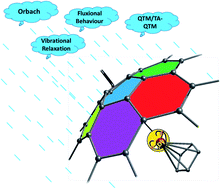In silico design to enhance the barrier height for magnetization reversal in Dy(iii) sandwich complexes by stitching them under the umbrella of corannulene†
Abstract
Lanthanide based single molecular magnets (SMMs), particularly dysprocenium based SIMs, are well known for their high energy barrier for spin reversal (Ueff) and blocking temperatures (TB). Enhancing these two parameters and at the same time obtaining ambient stability is key to realising end-user applications such as compact storage or as qubits in quantum computing. In this work, by employing an array of theoretical tools (DFT, ab initio CASSCF and molecular dynamics), we have modelled six complexes [(η5-corannulene)Dy(Cp)] (1), [(η5-corannulene)Dy(C6H6)] (2), [(η6-corannulene)Dy(Cp)] (3), [(η6-corannulene)Dy(C6H6)] (4), [(exo-η5-corannulene)Dy(endo-η5-corannulene)] (5), and [(endo-η5-corannulene)Dy(endo-η5-corannulene)] (6) containing corannulene as a capping ligand to stabilise Dy(III) half-sandwich complexes. Our calculations predict a strong axiality exerted by the Dy–C interactions in all complexes. Ab initio calculations predict a very large barrier height for all six molecules in the order 1 (919 cm−1) ≈ 3 (913 cm−1) > 2 (847 cm−1) > 4 (608 cm−1) ≈ 5 (603 cm−1) ≈ 6 (599 cm−1), suggesting larger barrier heights for Cp ring systems, followed by six-membered arene systems and then corannulene. DFT based molecular dynamics calculations were performed on complexes 3, 5 and 6. For complexes 3 and 5, the geometries that are dynamically accessible are far fewer. The range of Ueff computed for molecular dynamics snapshots is high, indicating a possibility of translating the large Ueff obtained into attractive blocking temperatures in these complexes, but the converse is found for 6. Furthermore, an in-depth C–H bond vibrational analysis performed on complex 3 suggests that the vibration responsible for reducing the blocking temperature in dysprocenium SIMs is absent here as the C–H bonds are stronger and corannulene steric strain prevents the C(Cp)–Dy–C(Cor) bending. As [(η6-corannulene)TM(X)]+ (TM = Ru, Zr, Os, Rh, Ir and X = C5Me5, C6Me6) are known, the predictions made here have a higher prospect of yielding stability under ambient conditions, a very large Ueff value and a high blocking temperature – a life-giving combination to new generation SMMs.



 Please wait while we load your content...
Please wait while we load your content...